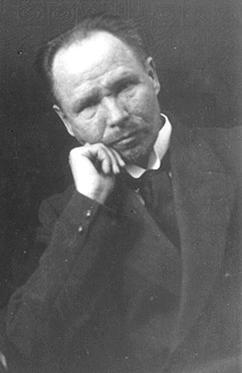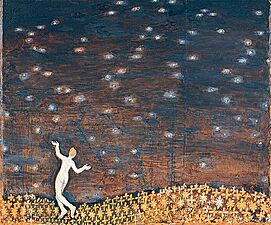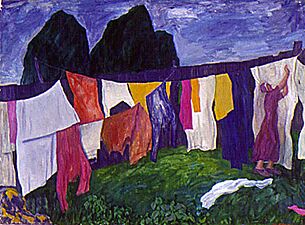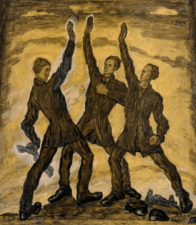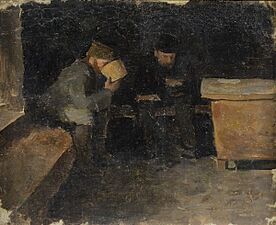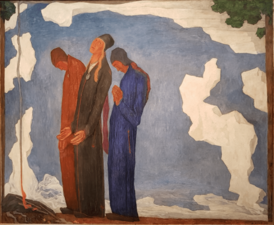Kristjan Raud facts for kids
Kristjan Raud (born October 22, 1865, died May 19, 1943) was an Estonian painter and illustrator. He is known for his unique art style. He often used ideas and characters from Estonian folklore in his paintings. Kristjan Raud was also one of the people who helped start the Estonian National Museum. His twin brother, Paul Raud, was also a well-known painter.
Contents
Kristjan Raud's Life
Early Years and Education
Kristjan and his twin brother, Paul, grew up in a place called Meriküla. Their father worked as a field ranger. After their father passed away, the brothers went to school in Rakvere. They were taught in German there. Later, Kristjan went to a teachers' college in Tartu. He taught in local schools for several years.
In 1892, Kristjan decided he wanted to be an artist. He moved to Saint Petersburg. There, his drawings were noticed by Johann Köler, a famous artist. Köler saw Kristjan's talent. He advised Kristjan to join the Imperial Academy of Arts.
After four years of study, Kristjan went to Germany. He wanted to make his art skills even better. He spent time in Düsseldorf with Peter Janssen. Then he moved to Munich. In Munich, he took private lessons from Anton Ažbe. He also took classes at the Academy of Fine Arts, Munich.
Return to Estonia and Museum Work
Kristjan came back to Tartu in 1903. He started a school for young artists. He also wrote articles for local newspapers. He taught at a school called a gymnasium.
After Jakob Hurt, a famous folklore collector, died in 1907, Kristjan had an idea. He wanted to create a museum. This museum would be dedicated to Estonian folklore. Two years later, he helped to start and organize the Estonian National Museum. The next year, he drew pictures for the collected poems of Juhan Liiv.
Later Life and Famous Works
When World War I began, Kristjan moved to Tallinn. He lived with his brother there. He became a teacher again while still painting. In 1919, he finished a painting called The Maiden of the Grave. He was also chosen to be the Chairman of the Estonian Museum Society. He started working for the Ministry of Education.
In 1924, Kristjan left his job to focus only on his art. A year later, he married a young woman. They had three children together. A very important moment in his career happened in 1935. The Estonian Literary Society released a new version of Kalevipoeg. This is the Estonian national epic story. Kristjan's paintings were used as illustrations for the book. The first printing made 10,000 copies. This was a very large number for that time.
In 1938, Kristjan Raud received an award. It was called the Order of the Estonian Red Cross. Kristjan loved painting so much that he kept painting even when he was sick in the hospital. He passed away in 1943 during the German occupation of Estonia during World War II. Because of the war, his funeral was very quiet.
Legacy and Recognition
In the spring of 1940, a big exhibition of Kristjan's artworks was held. The government even called it "Kristjan Raud Year." After he died, a monument was built to honor him in 1969.
Four years later, the Kristjan Raud Art Award was created. This award is given by the Estonian Artists' Association and the city of Tallinn. From 1992 to 2011, Kristjan Raud's picture was on the one Estonian kroon banknote. This was before Estonia started using the Euro currency.
Selected paintings
Images for kids


